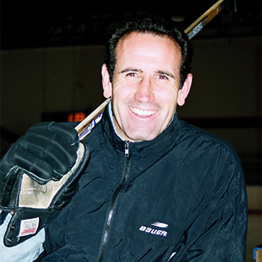Many power skating drills focus on balance techniques not used during a game such as balancing on one foot for extended periods of time, dancing the polka on ice, the “duck walk” and the “railroad.” It is questionable if these types of drills are of value when trying to improve game-performance skating ability.
Research on game performance skating (Bracko, 1998) shows that gliding on one foot is not a skill used by hockey players. The specificity of training rule indicates that in order to improve the performance of an athlete, the training must be similar to the way the athlete will perform in a game.Many power skating instructional protocols emphasize forward and backward leg and arm/shoulder movement (flexion/extension) as being a characteristic of high performance skating. Movement of the legs straight backward is impossible during low, medium and high intensity skating, and contradicts the law of physics – Action-Reaction (Van Ingen Schenau, et al, 1985). As a result, it is impossible to move the arms backward and forward as well.
Forward and backward movement of the shoulder contradicts the physics law of action – reaction.Power skating instructional protocols typically require players to line-up at the ends of the rink (for instructional purposes) where upon the players practice drills from end to end. Bracko (1993) analyzed five, 70 minute, power skating sessions at a summer hockey camp, and found the players were engaged in time-on-task for 10 minutes, unproductive movement for 10 minutes, and stood in line waiting for their “turn” for 50 minutes.
This type of instructional protocol and movement pattern allows for an average of ten seconds of “time-on-task” (time actually spent practicing the drill) before reaching the other end of the rink which is probably not be enough time to develop muscle memory for the skating (Bracko, 1993) Players in typical power skating programs spend the majority of their time standing in line, and a minimal amount of time actually practicing skills.Using progressions is a near-sacred principle in power skating and is taken most seriously by instructors. Progressions, when teaching skating, involves breaking the skill into many small parts, practicing the parts, then attempting to put all the parts together for the full skill. This has been found not to work in other sports:
“The research evidence indicates that the faith in using progressions, at least in some cases, may be misplaced.” (Nixon and Locke, 1973). “Progressions generally appear not to be significant factors in learning many motor skills.” (Nixon and Locke, 1973). “Anything less than a game situation, unless very well planned, has the possibility of introducing artificial situations, and complete transfer to the game situation might not occur. If drills are used, the teacher should carefully consider the environmental-movement relationships in the drill to determine that they are as close to the game situation as possible.” (Marteniuk, 1976).A better method of teaching skating may be to apply the “specificity of training” rule which could be called “Performance Skating.” Specificity of training dictates that in order to prepare a hockey player for better performance, he or she should practice the way the game is played.
Performance skating focusses on the specific characteristics that enhance game-performance skating. Performance skating allows players to practice skills for a period of time followed by a rest. There is approximately a 1:4 work to rest ratio: 30 – 45 seconds of skill development to 90 – 120 seconds of rest.
The use of video for instruction can be a powerful teaching tool.

Hockey Institute – All Rights Reserved – Calgary Web Design by Blue Ocean